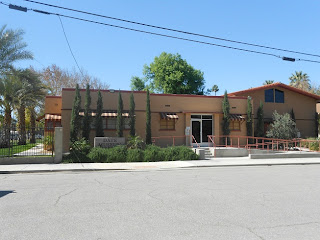 |
| Southern Pacific logo on front of diesel locomotive |
California in particular was a focal point of railroad building. First of all, the state of California was growing rapidly ever since the gold rush days of the 1850's. Secondly, California was the ultimate destination for a southern rail route that would serve both Los Angeles and San Diego from the east. California railroads and their connection to markets in the east was a top priority.
Western Trips visited a historic site that was part of the southern route to California which is also the story of the Southern Pacific Railroad.
Indio California and the Southern Pacific Railroad
Indio California, on the eastern edge of the Palm Springs desert string of towns, was a key location for the Southern Pacific Railroad which eventually controlled tracks from Texas to California. Indio was established as a halfway point for the Southern pacific between Los Angeles and Yuma Arizona.
 |
| Coachella Valley Museum, Indio CA |
Indio California took off rapidly after the railroad arrived and literally became a beacon of civilization in the middle of the desert. The California railroads had the same effect on many other towns. Stores and hotels sprouted up to help serve many of the workers who found themselves in a very sparse and harsh desert environment. If there were social activities during this era in the desert, it took place at Indio. Today of course, Indio California and it's neighboring desert communities are a desert spa resort mecca with beautifully manicured golf courses.
The Continuing Growth of Indio California
Many booming railroad towns of the last half of the nineteenth century faded from glory. Some disappeared entirely. We've written about some of these towns on Western Trips articles. Not so with Indio.
 |
| 1920's kitchen stove exhibit at Coachella Vallley Museum |
Desert Water
Much of this agricultural success had a lot to do with the farmer's being able to attain ample water. The first water was obtained from artesian wells and then eventually through canals.Canals were built westward from the Colorado River. Today the Coachella Valley of California receives water from three sources. Groundwater, recycled water and imported water either through the State Water Project or from the Colorado River via the Coachella Canal, a branch of the All-American Canal. Farmers in the Coachella Valley today receive about a third of their water needs from groundwater. The majority of their water comes from the Colorado River via the Coachella Canal.
Links to four additional Western Trips photo articles you'll find interesting include:
Joshua Tree National Park
Unique Railroad Museum Exhibits
Railroad Square in Santa Rosa California
San Diego's Popular Gaslamp Quarter
 |
| Date Museum at Coachella Valley Museum campus |
The Palm Springs desert communities offer a wide variety of recreation opportunities. The hot summer days give way to ideal winter weather. While there's many things to do in Palm Springs and the other communities, I think you'll enjoy a visit to the Coachella Valley History Museum. It's a fun low cost stop to place on your vacation planner and you'll really get a good idea of how the desert communities grew to what they are today. California railroads played a major part in the settlement of many towns you visit today.
The Coachella Valley History Museum displays the unique history of the desert and the pioneers who forged through the difficult environment to create the home it is to so many today.
When visiting this well planned museum, you'll view exhibits and artifacts from the days of the early Southern Pacific Railroad,the early farms of the Coachella Valley. You'll also see town and valley artifacts that portray what life was like in a new California desert settlement.
 |
| 1909 India California schoolhouse |
The date has been a very important product for the Coachella Valley.The Date Museum recreates scenes found in many of the early shops that brought the date to the forefront of agriculture in California.
One interesting exhibit we found in the Smith-Tyler House is the Pioneer Kitchen. The restored kitchen is an accurate example of a 1926 kitchen. The items you'll see include an icebox, stove, butter churn, and various tools of the 1920s.
The 1909 schoolhouse on the Coachella Valley Museum campus is one of Indio’s oldest surviving buildings. The school was originally built on the site of the current Greyhound Bus Depot. It served as a hospital during the 1918-19 flu epidemic and was converted during the 1930s to be used as a classroom and cafeteria for Roosevelt School. In 1999, the city of Indio moved the school to its present site and performed restoration.. You'll notice that the original tin ceiling, floors, cabinets, and the majority of the original windows remain intact.
There's certainly many things to do in Palm Springs and it's neighboring communities. Visiting the Coachella Valley Museum and learning more about the Southern Pacific Railroad, California railroads in general and life in an early desert settlement is a good and fun addition to your southern California vacation planner.
The Coachella Valley History Museum is open the beginning of October to the end of May from 10am to 4pm on Thursday, Friday, Saturday; and 1pm to 4 on Sunday.
(Photos from author's collection)
View Larger Map

